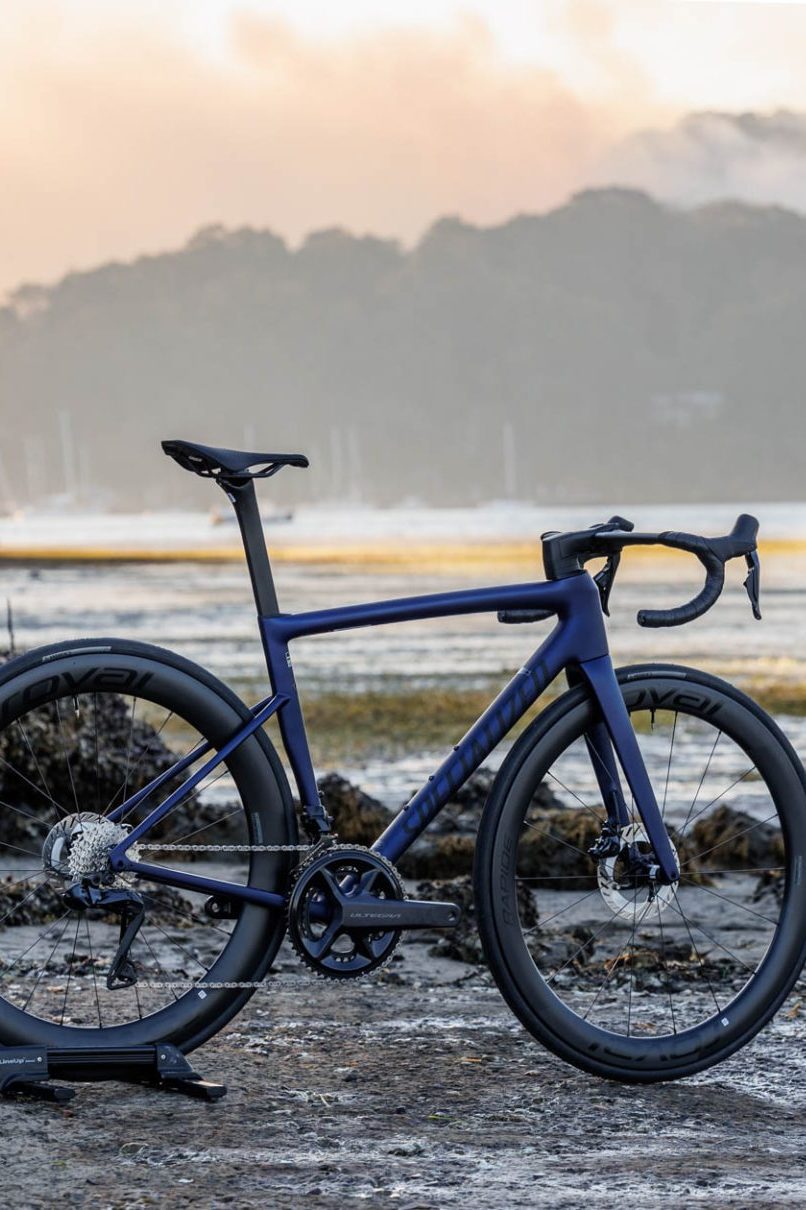Typically you can expect bike reviews on Escape Collective to be exhaustive and as a result, long. While this is no different, so much to know about the new Tarmac SL8 has already been covered in our initial bike release and build report.
Consider this review the expansion pack to that original coverage. Here, you’ll find a short refresher of the bike plus how I’ve gotten along with it over the past few months, including the ride to expect, thoughts on the parts equipped with the second-tier Pro model, and the few shortcomings. For everything else, go check that article from August 2023.
Pros: A ride quality that is my new benchmark for race bikes, impressively reactive and enjoyable under power, easy to service as far as integrated race bikes go, quality build kit with no obvious weaknesses.
Lows: Stock handlebar width isn’t aero, messy Di2 integration for rear derailleur, upgrade to one-piece cockpit requires spare steerer length, gap beneath headset top cover, round spokes are a cost-saving measure.
Total weight: 7.11 kg / 15.7 lb (without pedals or cages, but with computer mount and tyre sealant)
Price: US$8,500 / AU$11,900 / €8,500 / £8,000
A quick recap
Only a handful of road bike models on the market attract quite as much attention as the Specialized Tarmac. A big part of that is the company’s ability to create a lot of noise, but no matter how big the megaphone is, they still need something to say. And as one of the consistently best-selling road models, the Tarmac has earned a reputation for being a damn good road race bike.
Wind back three years and Specialized’s Tarmac SL6 was well regarded as a fantastic riding bike. It offered lively handling, it was light, stiff enough, and comfortable for riding all day. It had some aero cues, but its visible brake hoses had it looking slightly dated by the time it was superseded. Along a similar timeline was the Specialized Venge, a dedicated aero road bike that was arguably the faster option, and yet, many of Specialized’s top pros, such as Peter Sagan and Julian Alaphilippe, would more commonly still pick the Tarmac SL6.
Then came the Tarmac SL7, a road bike that promised to be everything the Venge was, but with a weight close to the SL6. The SL7 looked a whole lot like the Venge, and Specialized included new wheels (Roval Rapide) and an updated cockpit to tell a story of the Tarmac being faster than the now-superceded dedicated aero bike. And despite a shaky start with a voluntary safety recall, the Tarmac SL7 was, and still is a great bike.
Finally, we come to Specialized’s latest all-rounder race bike, the Tarmac SL8. It’s a bike that retains the same proven geometry figures as SL6, Venge, and SL7 before it, yet it’s claimed to be lighter, stiffer, smoother-riding, and a smidge more aero than all before it.
The structural lessons are said to be learned from the Californian company’s lightweight Aethos. More cynically, they’re lessons learned before the pursuit of making every tube into a truncated airfoil became the priority of the modern road market. Indeed, the top tube, down tube, and chainstays have had the clock wound back and are now close to shapely cylinders. Meanwhile, the aerodynamic gains of the SL8 are subtle, with as much as 80% of the claimed 5 watt-improvement (compared to the SL7) attributed to the new one-piece Roval Rapide cockpit of the S-Works model (claims are without a computer mount in place). The remaining gains are in the fork legs that are now more similar to the discontinued Venge, a slimmer seat tube and seatpost combo, and a head tube that stole the show.
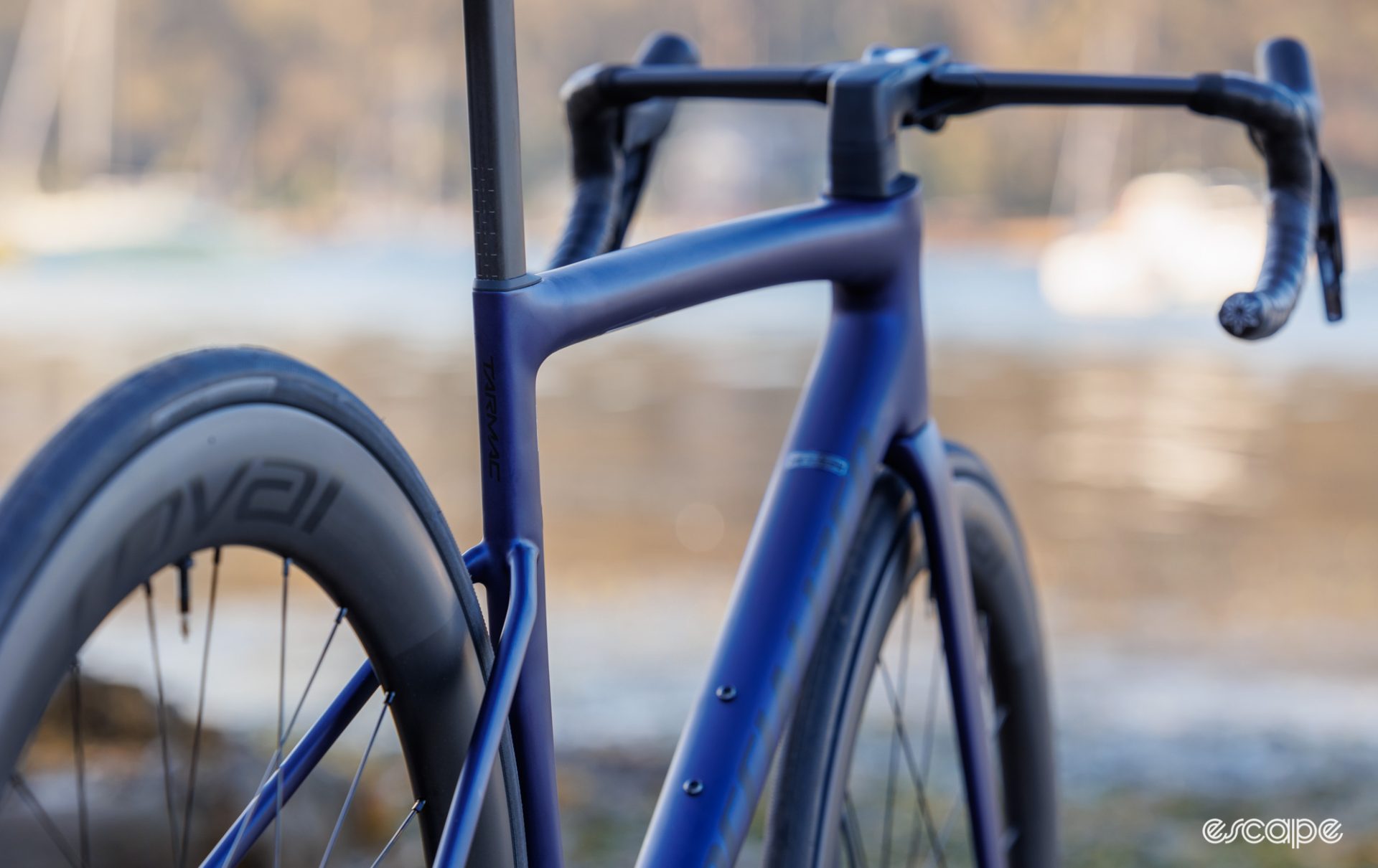
The head tube is elongated forward of the steerer tube. Specialized humorously named it the Speed Sniffer, and indeed, the nose-looking shape aims to create a narrower frontal profile for the air ahead to smoothly attach to rather than first hit a big bulbous head tube. No doubt there’s something to the design, which is probably why both Pinarello and Trek have used similar concepts before, too.
“With a rider on the bike, the leading edge is what matters most for aero – that’s why the cockpit, fork legs, and head tube were optimized accordingly,” said Specialized’s road product manager Miles Hubbard when asked why the rest of the bike was arguably made less aero. “Truncated tubes elsewhere on the bike can negatively impact weight and ride quality thus making for a slower package overall,” added Hubbard, while pointing to the company’s SL8 white paper for a deeper explanation. Either way, it appears Specialized is now saying #aeroisnoteverything (niche bike dork joke).
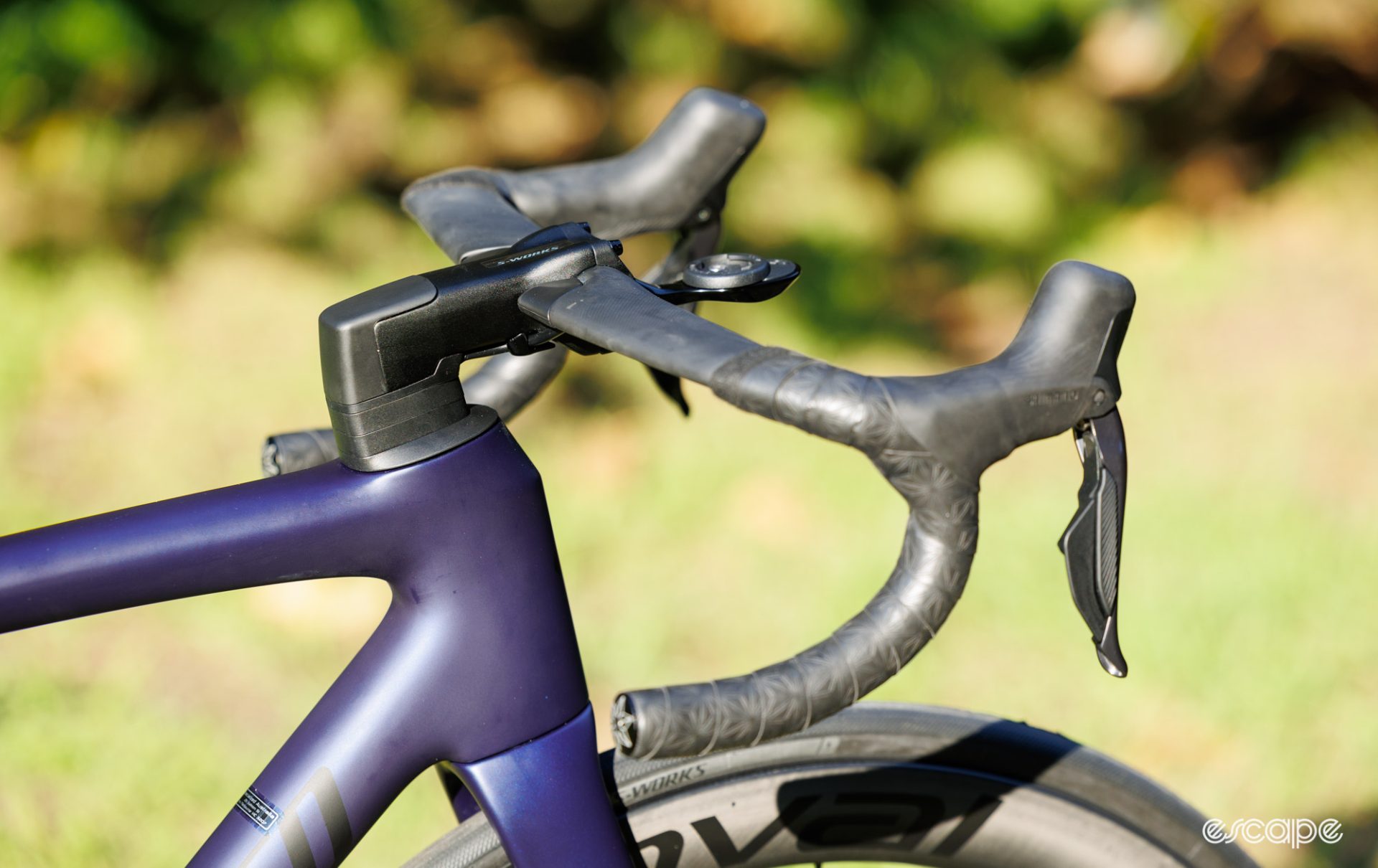
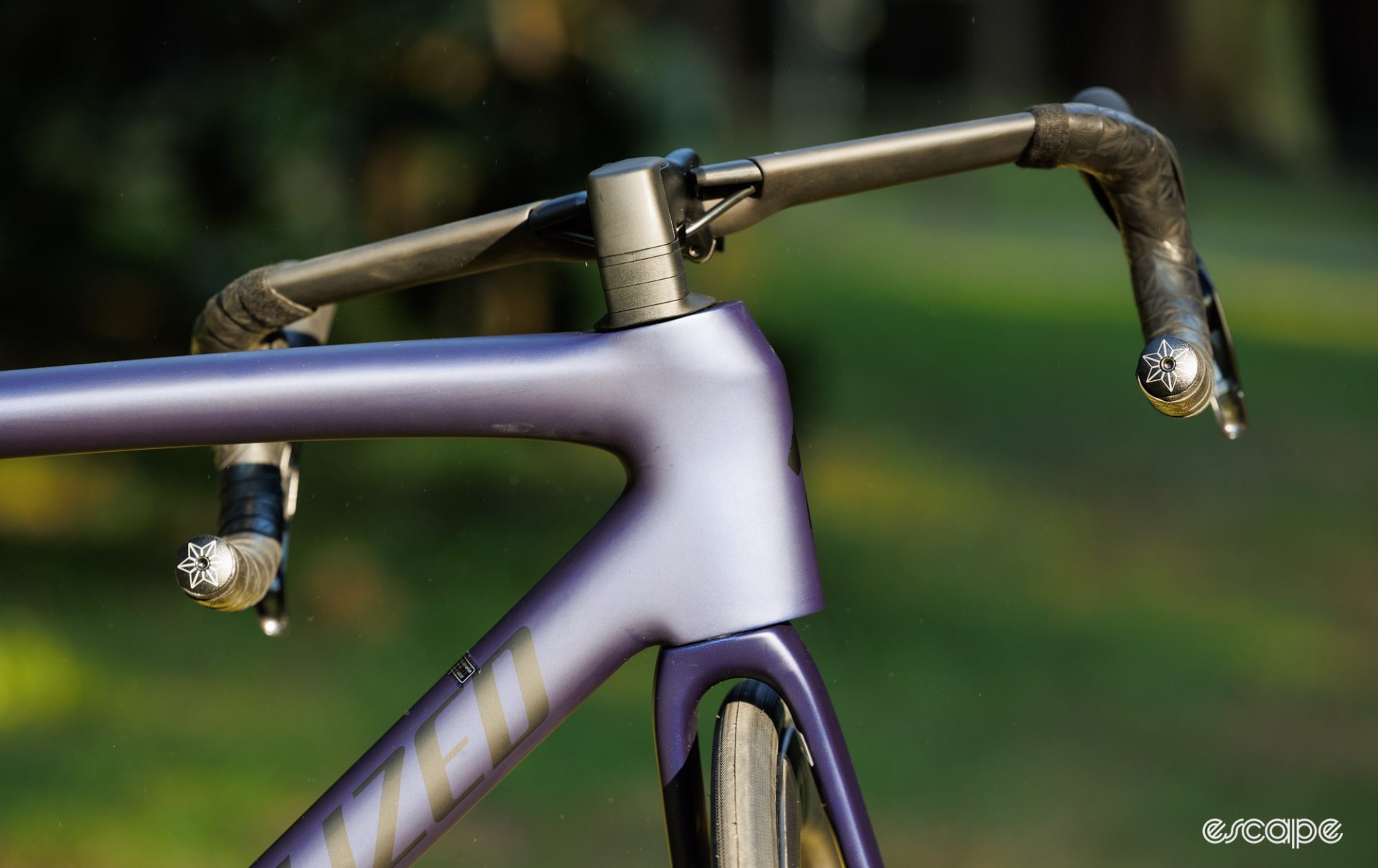
OK, so unless you’ve got access to an accurate wind tunnel or are willing to spend countless hours Chung’ing it with Golden Cheetah, the new SL8 is arguably undetectably as aero as the SL7. That’s certainly true for the SL8 Pro version tested here which features an identical two-piece bar and stem to the former flagship SL7. Meanwhile, the statement also remains rather true if you were to put the new Roval Rapide one-piece cockpit (as supplied with the SL8 S-Works) onto an older SL7. Unfortunately, at Escape Collective, we’re no closer to putting exact aero numbers to bikes, and so I can’t offer any useful insight into how the SL8 may compare to similar lightweight do-it-all race bikes such as the Cannondale SuperSix Evo, Canyon Ultimate CFR, or the like.
Weight-wise, Specialized claims to have saved weight all while increasing stiffness in key areas. Combining those two metrics, the stiffness-to-weight ratio is way up, by more than 30% apparently – impressive given the Tarmac models that came before were hardly bad in this regard.
Specialized claims just 685 grams for a 56 cm painted S-Works frame and 358 g for the matching fork. All other models of the SL8, including the Pro reviewed here, feature a lower-grade carbon fibre layup (10r in Specialized speak) that’s claimed to add approximately 100 g for the frame, and 10 g in the fork. Meanwhile, Rhino’s Workshop in London shared a long list of verified SL8 frame weights, ranging from as low as 648 g (49 cm, Ready-to-Paint) up to 808 g (56 cm, Dune White).
More weight details can be found in my previous coverage, but the short story is that it’s relatively easy to hit the UCI 6.8 kg weight limit with an SL8. In fact, my second-tier Pro Ultegra tester weighed in at just 7.11 kg / 15.7 lb (without pedals or cages, but with the supplied alloy computer mount and 60 ml tubeless sealant in each tyre) – that’s wonderfully light for a modern disc-equipped bike with such deep hoops.
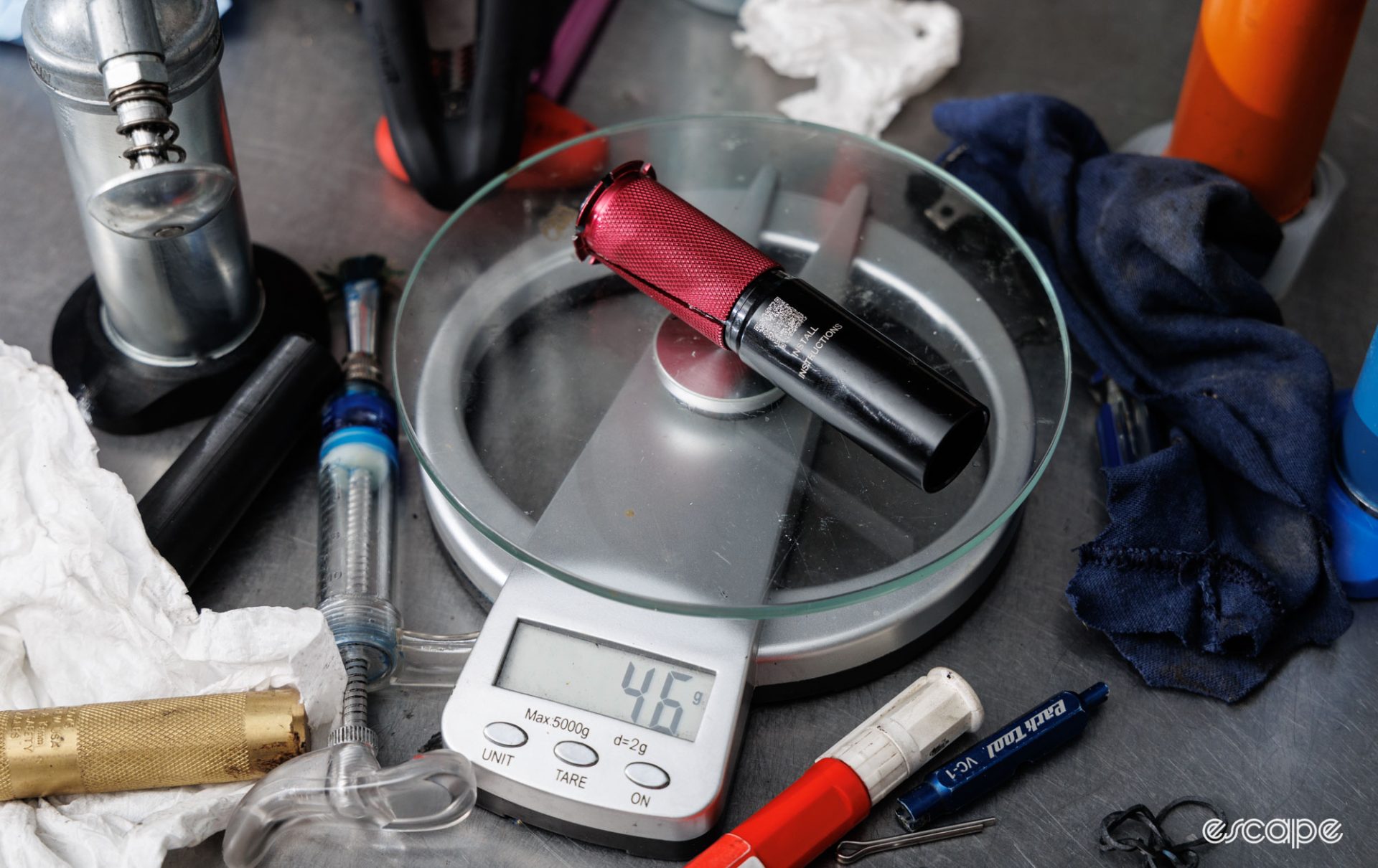
All the finer technical details have been covered previously, but some highlights include a seatpost that at 18.5 mm at its widest is so slender a Shimano Di2 battery must be mounted beneath it (the frame is electronic gears only). There’s a regular English threaded bottom bracket. Up front, Specialized sticks with the same round tapered fork steerer and ultra-long compression plug seen in the SL7 – just now there’s a new approach to the headset compression wedge. As for the all-important tyre clearance, there’s officially room to fit 32 mm rubber front and rear.
Ride report
Riding any modern road bike at this price point will provide an enticing experience to anyone looking to go fast. However, there are always subtle nuances that separate one bike from another, and in most cases, those nuances may positively sway in one direction and perhaps introduce a compromise or two elsewhere. By contrast, there is lots of nuance to why the Tarmac SL8 feels like a great bike, but impressively, it achieves that with such balance that there’s no obvious downside.
Most apparent was how smooth the SL8 feels at speed. This is far more than a good saddle or supple tyres, with the frame playing an undeniable part in reducing high-frequency vibrations and more obvious jolts. The outcome is a bike that encourages you to ride it further – perhaps the biggest praise I can give to any bike.
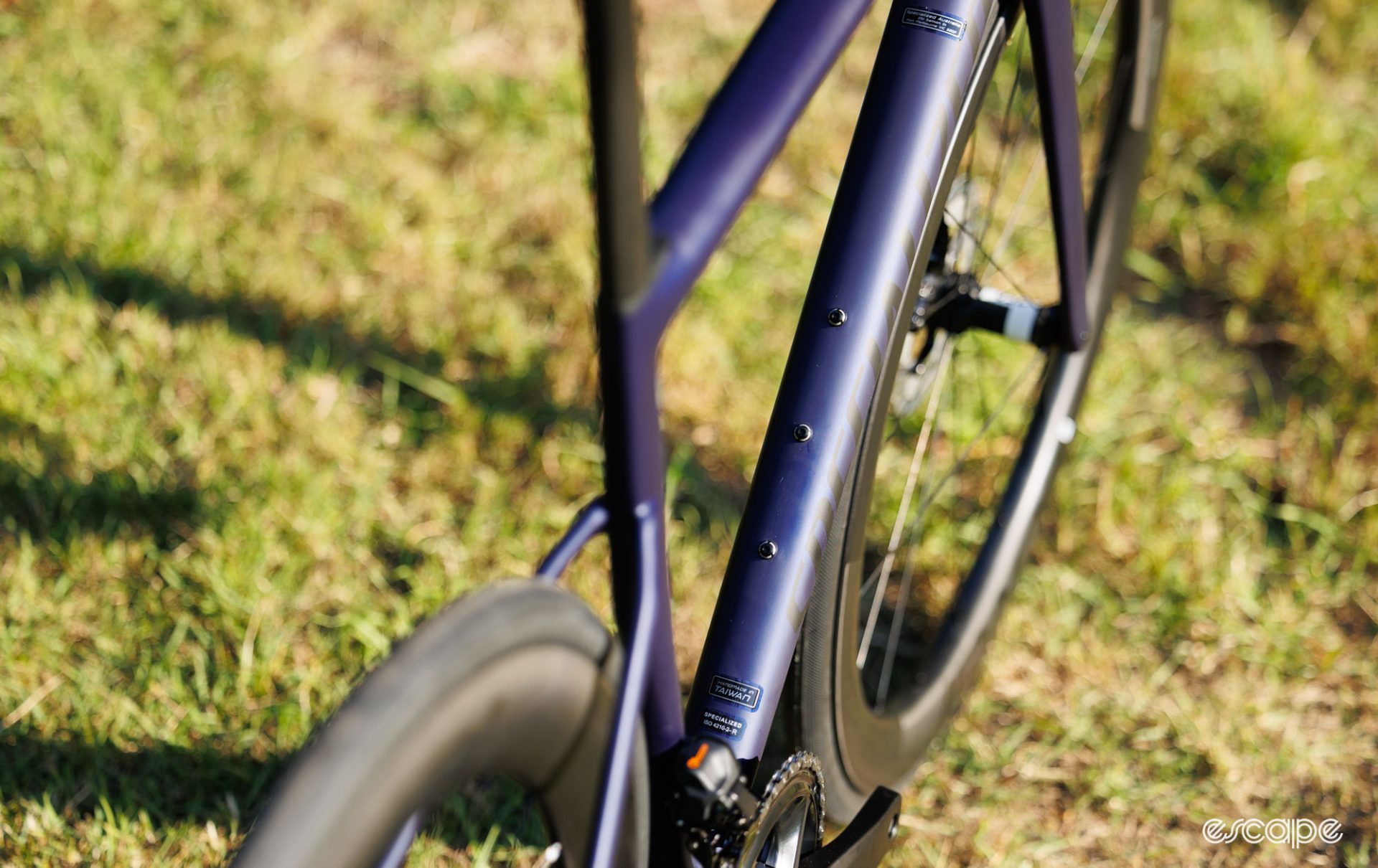
My untested and unconfirmed theory here is that so many modern race bikes claim to achieve vertical compliance but forget that a bike is rarely in a perfectly vertical plane. The SL8’s more traditional rounded tubes and ultimately slim seatpost offer something a little more, dare I say old school, in the dynamic way a bike moves.
That said, that smoothness isn’t the result of any obvious softness in the frame. Forceful efforts on the pedals uphill or flat-out high-cadence sprints are rewarded with a bike that pounces. This is one of those rare moments when increased rigidity actually feels beneficial, or at the very least, helps you focus on the task. And in these scenarios, the SL8 is as good as anything else I’ve tried with my prior benchmark arguably being the Trek Emonda SLR or BMC Teammachine SLR (unfortunately, I’ve yet to ride the latest generations of Cannondale SuperSix Evo or Canyon Ultimate). However, compared to those bikes I have tried in recent times, the Tarmac SL8 has that stiffness while being noticeably more comfortable and composed over less than perfect, um, tarmac.
Equally, the new Tarmac feels good under power while seated, too. I was initially concerned that the extremely thin seatpost would flex from side to side, but such worries were quickly quashed through it holding strong against any purposeful efforts for it to flex in an unwanted way. And up front, things are equally direct, and I’m told that a change to the one-piece Rapide cockpit only further improves that.
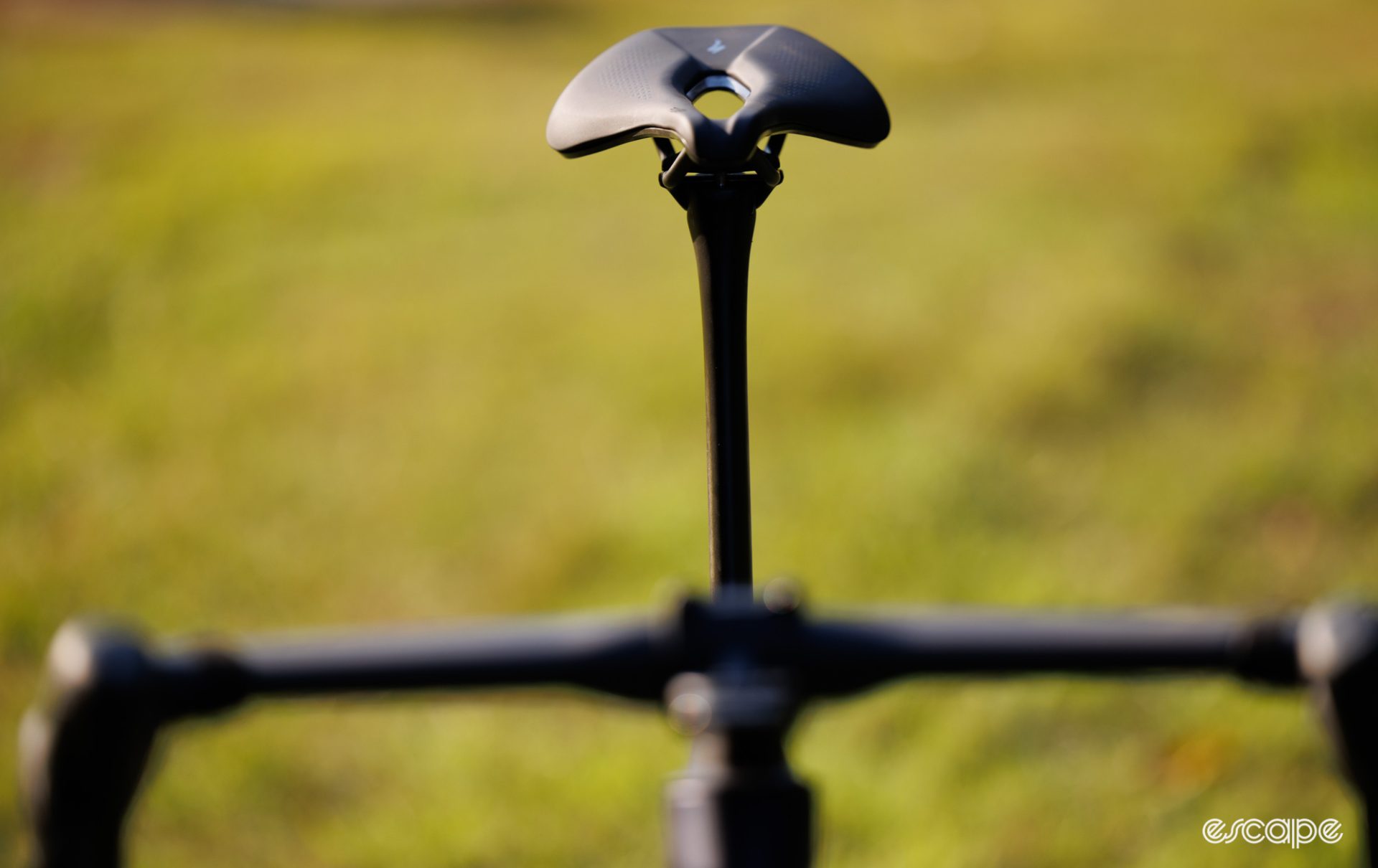
No doubt, the lightweight frame module helps create this feeling of rapid response and keeps things equally light high up on the bike when it’s being swung side to side. Time and time again, we’ve acknowledged that a lighter bike rarely makes a significant measurable difference, but there’s no denying the positive feeling that it provides.
All of this is to say that Specialized has managed to create a bike with incredible balance across the attributes that matter most. Now, that doesn’t mean things can’t still improve, and certainly, the pursuit of making things lighter, stiffer, more comfortable, and more aero will surely continue in minuscule amounts for future iterations. However, as of today, the Tarmac SL8 offers an impressive ride that is now my new benchmark for future comparisons.
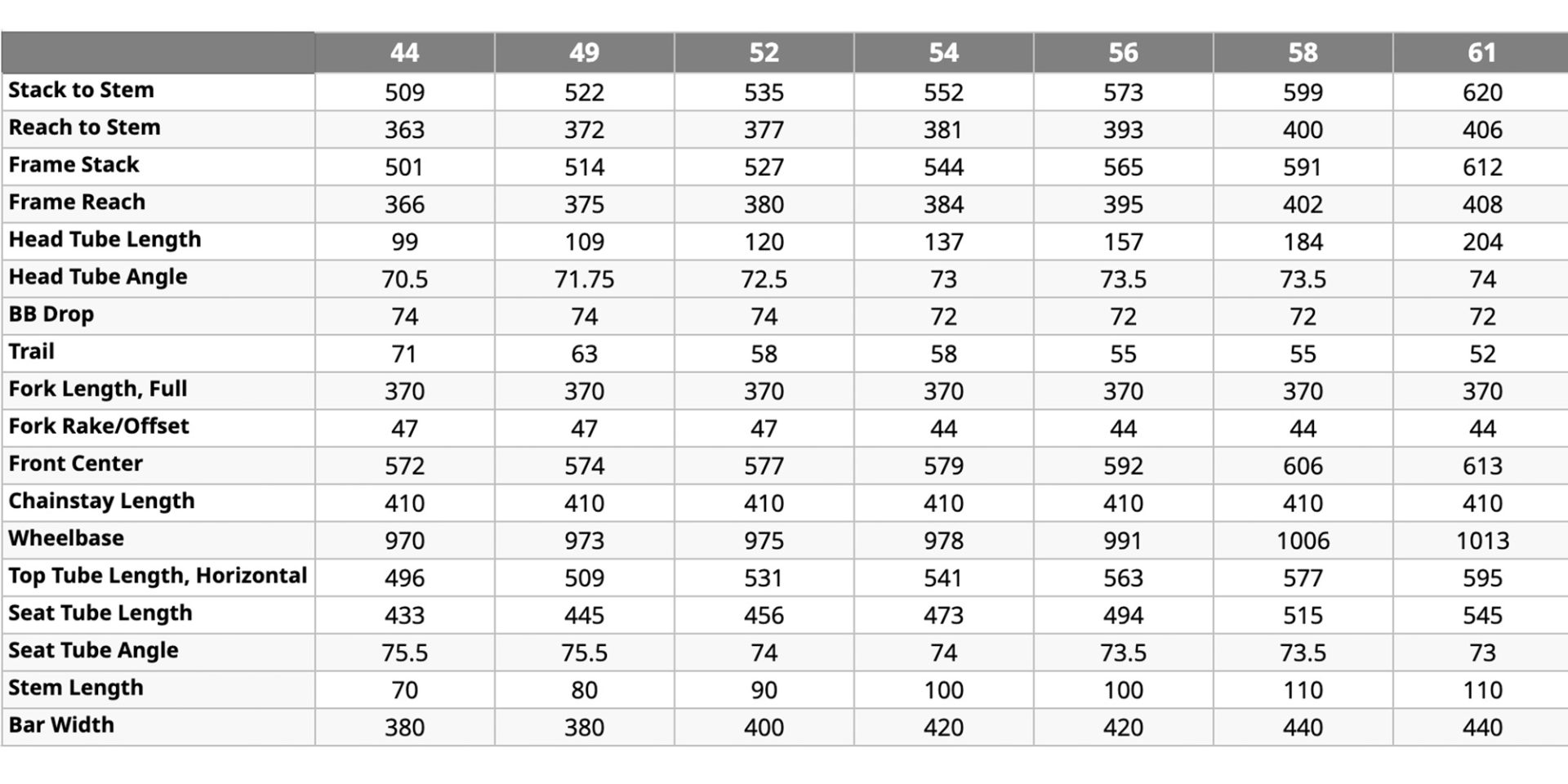
There isn’t much to add about the geometry and fit that hasn’t already been said over the past six or so years. The Tarmac has often been regarded as a lovely handling road bike, one that offers a relatively low trail figure to provide a ride that is twitchy enough to be as reactive as you’d ever want without it being a handful. It handles and feels like a race bike in every way, and it’s joyful to descend on a bike that reacts to input like this.
The fit geometry is equally race-focused with relatively low stack heights and marginally longer reaches. Amongst the SL8’s direct competition, the Canyon Ultimate CFR and Trek Emonda SLR are a couple of millimetres more aggressively positioned, while most other competing bikes tend to offer marginally more relaxed fits.
| Bike | Size | Stack (mm) | Reach (mm) | Stem length (mm) |
| Canyon Ultimate CF SL | Small | 539 | 390 | 90 |
| Trek Emonda SLR | 54 cm | 541 | 386 | 90 |
| Specialized Tarmac SL8 | 54 cm | 544 | 384 | 100 |
| Giant TCR Advanced | Medium | 545 | 388 | 100 |
| Cervelo R5 | 54 cm | 547 | 380 | 100 |
| BMC Teammachine SLR01 | 54 cm | 550 | 386 | 100 |
| Polygon Helios A | Medium | 550 | 385 | 110 |
| Cannondale SuperSix Evo | 54 cm | 555 | 384 | TBC |
| Cervelo Caledonia | 54 cm | 555 | 378 | 100 |
| BMC Roadmachine | 54 cm | 562 | 386 | 100 |
It’s worth noting that out of the box the SL8 comes with a generous stack of 35 mm headset spacers which can be used to produce a marginally more upright ride position (although still a few centimetres short of the endurance-type fit that many of us would benefit from). Also, the one-piece Roval Rapide bar (stock on the S-Works) sits about 8 mm higher than the SL7-style stem/bar I tested – although it too can be lowered to match with a change of headset top cap. My personal preference (or injury-based requirement) these days is for a less aggressive and hinged fit, so for my 54 cm tester, I ran 25 mm of spacers along with a 10 mm-shorter stem (stock is 100 mm on a 54 cm) – a fit I found comfortable, but if racing, I’d be returning to the 100 mm.
So far this all sounds rather gushy, and I’ll admit, this bike doesn’t get much wrong (what it does, I’ll get to). To support these findings I put a call out over Instagram for others who had ridden the SL8 to provide feedback. In almost all cases, those comments were equally gushy, pointing out that they felt the SL8 was smoother, stiffer, certainly lighter, and maybe a tad faster than their previous bikes (often an SL7). In other cases people couldn’t say for certain whether the SL8 rode smoother than the SL7, or that it was, in fact, faster, perhaps pointing to how nuanced the iterative improvements have become in modern road bikes. Regardless of that, every single person I spoke with felt the SL8 was an improvement on the previous Tarmac.
Joel L, an Escape Collective member and Sydney local, has ridden many desirable bikes over the years (across many brands and materials). His observations about the Tarmac SL7 and SL8 are valuable as he is a paying customer from outside of the industry, and he’s owned S-Works versions of both built with identical components, right down to the Roval Rapide one-piece handlebar. “Although it’s minor, I feel that the slightly reduced weight of the overall bike is slightly discernible up the pinches and steeper climbs,” he says. “The back end does feel stiffer than the SL7, especially on some of the climbs where I’ve pushed it for a 10-20-second effort. I think there’s a bit of a placebo effect going on, but I feel downright faster on my SL8. I love it, I had no plans to sell my limited edition Venge, but the SL8 has changed that.”
Many others echoed Joel’s comments, and when pushed to say something negative, the repeated answer was simply related to aesthetics – I guess we’re a vain bunch. And I wholly agree – I’ve had the Tarmac SL8 in front of me for months, and every time that Speed Sniffer catches my eye, I pause to think how it ruins the look of an otherwise timeless-looking machine.

Speaking of aesthetics, I’ve grown to like the satin blue paint scheme of my Pro Ultegra test sample, but the matte-type paint does show fingerprints and all other forms of smudges. A good matte finish cleaner (Maxima is what I use) works wonders to keep the smudges at bay, but I still find it easier to live with gloss paint and future blemish fixes are also easier to correct. Specialized does offer my tested Pro Ultegra in a gorgeous gloss green that even Kermit would be jealous of, but unsurprisingly it seems to be in even higher demand. Meanwhile, you can also get a SRAM Force AXS-equipped version of this bike for the same money in a more subtle satin black colourway.
Talking spec on the Pro Ultegra model
So far I’ve mentioned the S-Works version a whole lot for a review that is for the second-tier Pro Ultegra version. At its centre, this second-tier version (and the models below it) features a frame that is only marginally heavier but otherwise intended to be identical in terms of stiffness, aesthetics, and aerodynamics (as far as the frame goes). Of course, many of the equipped components are also less expensive, and this produces a bike that saves US$5,500 / AU$8,000 / €5,500 / £4,000 when compared to an S-Works. These arguably small trade-offs result in big savings, although at US$8,500 / AU$11,900 / €8,500 / £8,000, the Pro version is still far from a budget offering.
Compared to the flagship (and pro-raced) S-Works version, the SL8 Pro Ultegra gives up on two aerodynamic gains. Firstly, you lose the one-piece Roval Rapide cockpit that’s responsible for approximately 4 watts of drag reduction and 50 g of weight saved. Meanwhile, the supplied Roval Rapide CL wheels provide identical rims to the flagship CLX wheels, but do so with thin (and less aero) round spokes and DT Swiss 350 hubs.
Now it’s worth noting that for US$600 / AU$850 / £475, and assuming you can buy stock anywhere (they’re seemingly more sold out than a Cadbury Creme Egg a month after Easter), you can buy a Roval Rapide one-piece cockpit to put onto any other Tarmac SL8 or even SL7. And you may want to do just that given the stock bar width provided (more below). Just beware that it requires an extra 10 mm of steerer versus the stock SL7 stem, a detail that could make or break future upgrade plans.

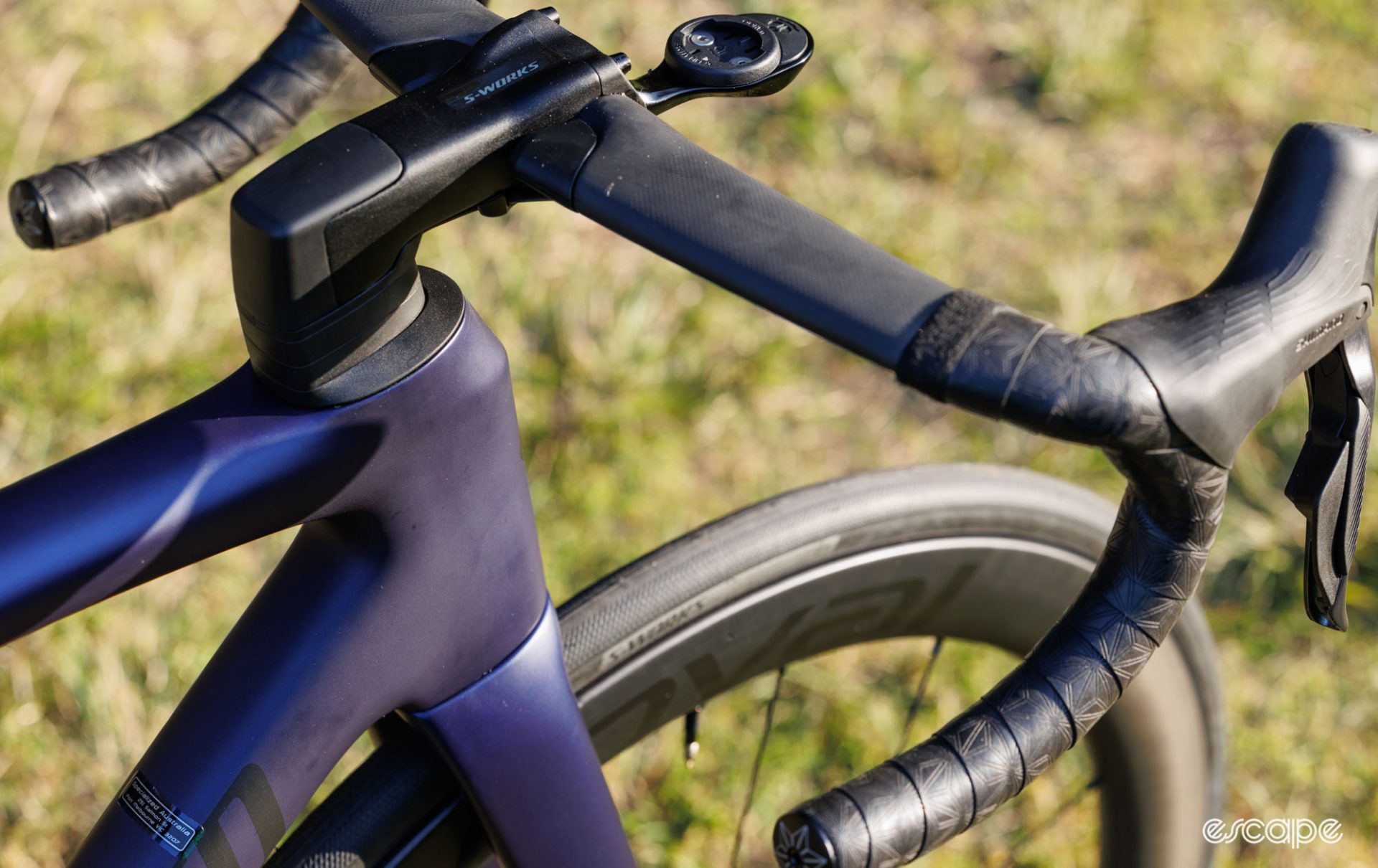
While marginally heavier and less aero, the provided two-piece bar and stem are still nothing to scoff at, and are in fact identical to the items previously supplied with the S-Works SL7. Here the SL7 aluminium stem is a reliable and easy-to-use item, matched with an impressively light and comfortable Roval carbon handlebar. Bonus points to Specialized for including a nice quality aluminium computer mount and also keeping the stem compatible with a host of other 31.8 mm handlebars. Out back, you get the 168 g S-Works seatpost (15 mm setback/380 mm length) in the extremely proprietary new shape.
Importantly the stem and headset design is relatively easy to get on with from a servicing point of view. You can swap out the stem length without having to disconnect brake hoses (assuming there’s enough slack in the hoses), and that design element also means you can create enough slack in the system to perform preventative maintenance to the headset bearings (cleaning and greasing the outer surfaces). I also didn’t experience any issues of loosening headsets or the like – it was all solid and quiet.
The only part that annoyed me with this cockpit is the daylight gap between the frame and headset topcover. Sure, run it too tight and you risk scoring the paint (as happens with many frames on the market), but I think there’s a happier medium. Miles Hubbard stated the headset is “designed to ensure no interference for a wide variety of production colorways and paint”, which makes sense, but given the price Specialized charge, perhaps they could match heights of headset compression wedges to each paint version of bike.
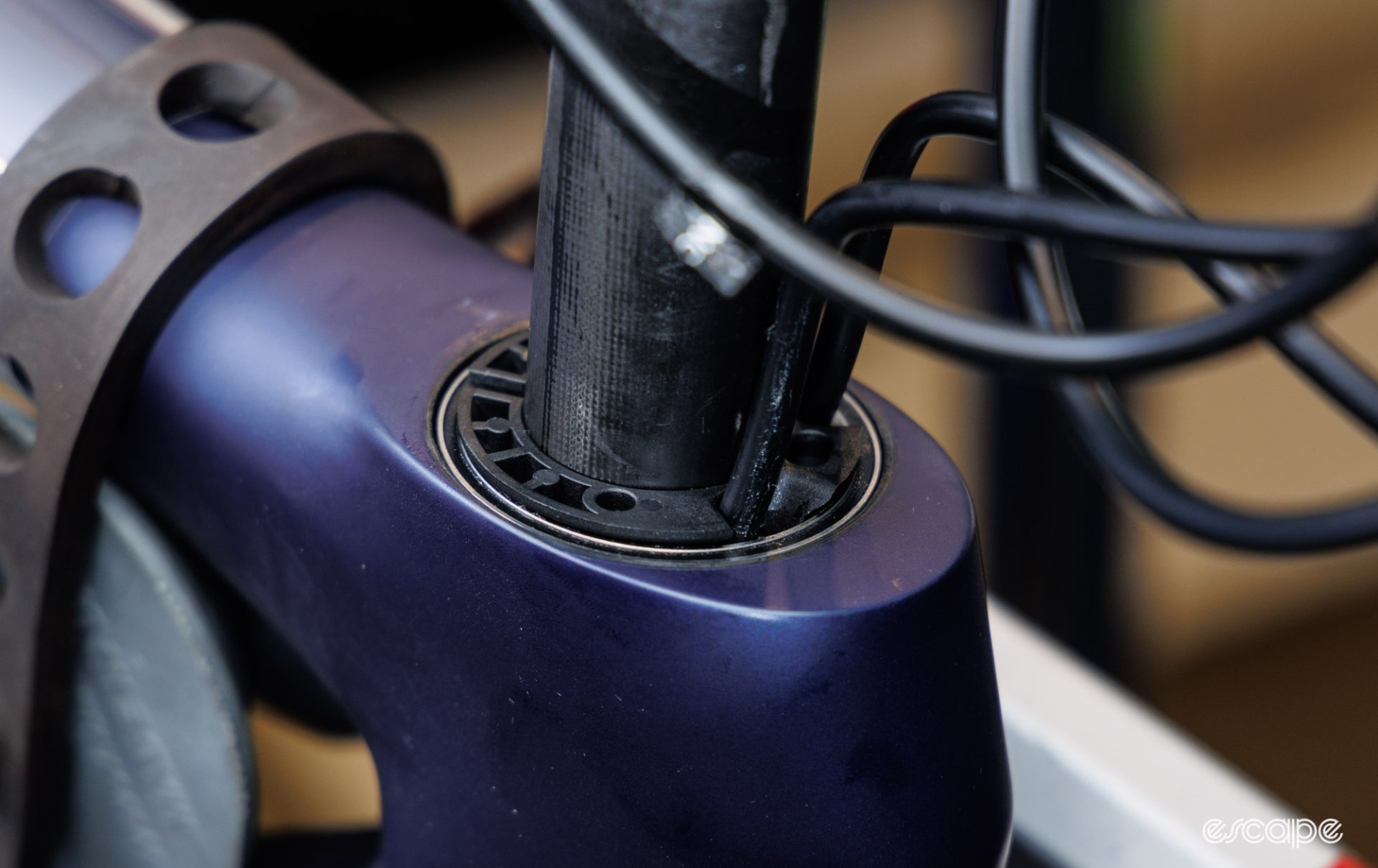

Those Roval Rapide CL II wheels (1,590 g with tape/valves) feature an unchanged rim shape from when they were first revealed alongside the SL7. Specialized has since updated the internal structure (and added some material) to now officially be tubeless-ready, but otherwise it’s a familiar affair. The 21 mm internal rim width is mated to front- and rear-specific rim dimensions, with the former being a stubbier 35.5 width and 51 mm depth, while the rear is a slimmer 31 mm external width matched with a deeper 61 mm profile.
These rims are impressively quick while offering a good amount of stability in typical windy conditions. And while the use of less-aero round spokes is nothing more than a cost-saving measure (which I’d prefer not to see on a bike of this price), I have nothing but praise for the reliable, proven, and wholly serviceable DT Swiss 350 hubs – so many OE-level hubs can be a nightmare to find spares for, but that’s not a concern here.
Specialized matches those wheels with its own S-Works Turbo 2BR tyres in a 26C version, the exact width the Rapide rim was aerodynamically optimised for. On these wheels, that tyre measures closer to an actual 27.5 mm (at 80 psi), and while I’d probably eventually go up a size to match Sydney’s often crummy roads, I didn’t feel an urgent desire to do so with the stock tyres.
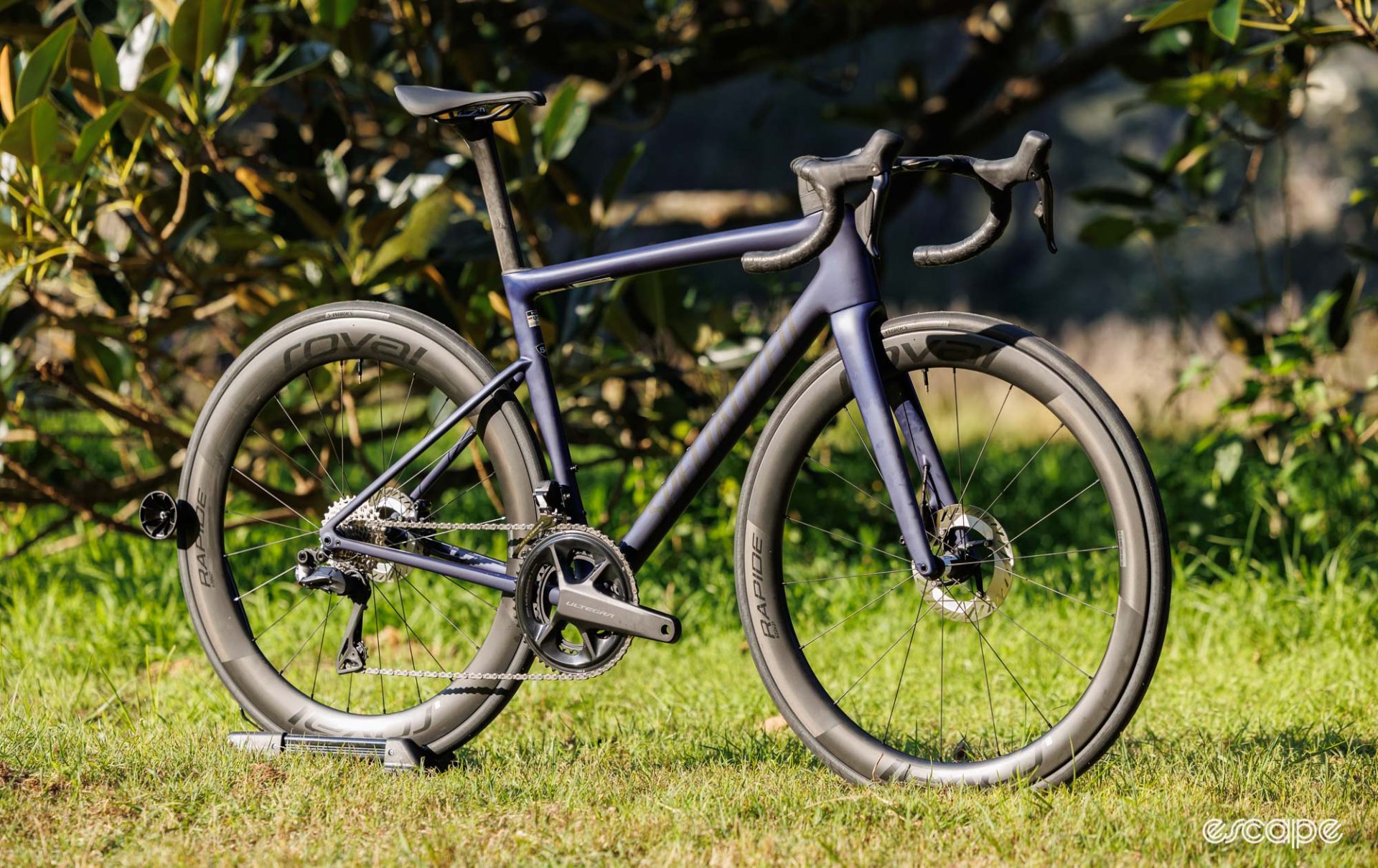
The stock tyres come with lightweight inner tubes inside, but Specialized also has pre-taped the wheels and provided valves for setting them up tubeless – something I elected to do and experienced no issues related to air retention or the like. Plus, the rims are hooked so there are far fewer limitations over what pressures you can run. That said, I did experience the valve nuts of the provided tubeless valves incessantly coming loose and then rattling, something I solved by placing small o-rings between the rim and valve nut (a common go-to trick of mine).
Finally, that brings me to the Shimano Ultegra R8100 Di2 drivetrain of my Pro Ultegra test sample. As it stands, this is my favourite of the premium road groupsets currently on the market due to its balance of shift quality, weight, price of spares, and care-free running. Its performance is almost exactly the same as that of Dura-Ace, it’s just approximately 200 g heavier. The shifting across the 11-30T cassette is wonderfully smooth under power and always consistent. Meanwhile, the front shift on the 52/36T rings has a speed and security simply unmatched by any of Shimano’s competitors.

The Di2 wiring between the chainstay and the rear derailleur is a little more exposed than I had expected for a bike of this price. Similarly, the Di2 battery placement beneath the seatpost creates significant complications (mostly for those on smaller frames), and I feel Cannondale’s use of a dedicated battery hatch is a more elegant solution to the problem.
Those considering the same-priced ‘Tarmac SL8 Pro – SRAM Force eTap AXS’ version will see a few hundred extra grams added to the bike for the benefit of truly wireless shifting. That wireless shifting erases any complaints I have related to the derailleur wiring or battery placement. Similarly, I find SRAM’s removable battery system simpler to own, even though it requires more frequent charging and there’s a risk of leaving your batteries at home. And another bonus point to SRAM for having a clutch-equipped derailleur that offers quieter and confident chain control when smashing down root-rippled roads.
The brakes are another factor when comparing SRAM and Shimano, and really the difference in feel arguably has more to do with personal opinion than actual stopping performance. I typically prefer the lever feel of Shimano which gives me feedback to the bite point, but it’s an extremely nuanced difference. In theory, a difference in brake fluid types means Shimano brakes (which use mineral oil) will require less frequent bleeding than SRAM’s use of DOT fluid, but anyone doing big distances should be having their brakes bled annually anyway.
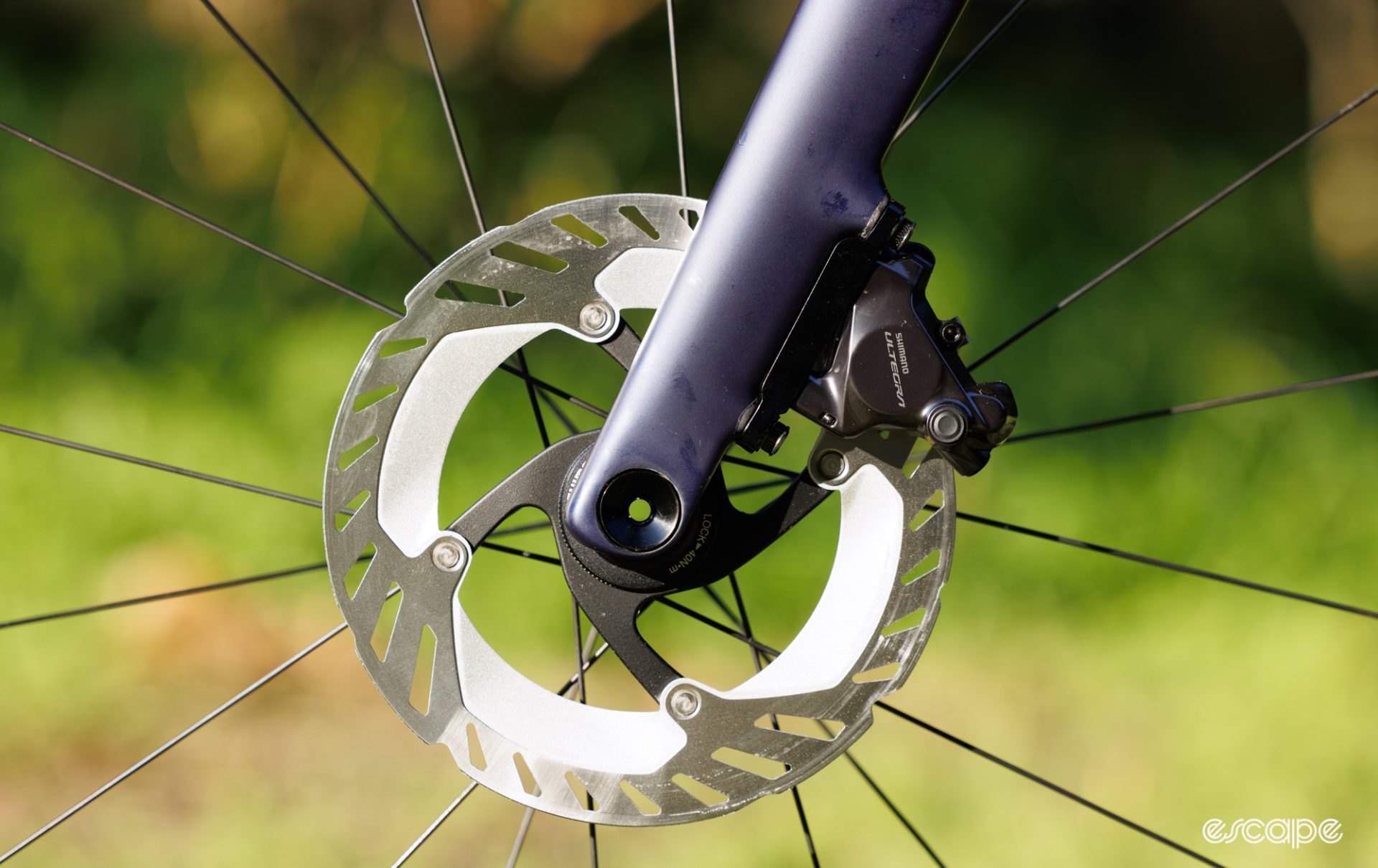
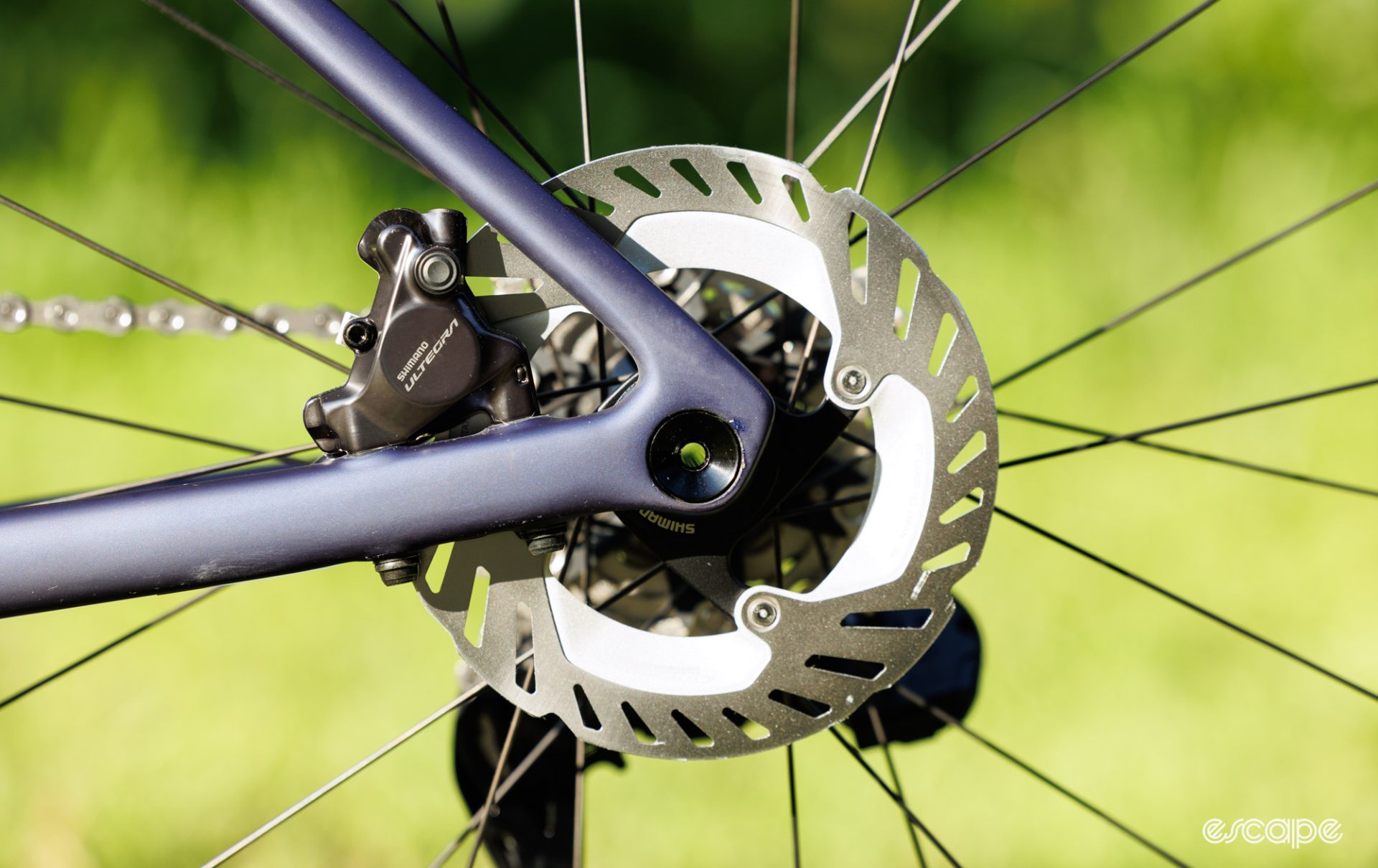
Another deciding factor between the Shimano and SRAM versions of this bike is the powermeter. My Shimano-equipped test sample includes a left-side 4iiii crank unit that offers fine numbers, but is obviously limited to how symmetrical your pedalling is. Meanwhile, the SRAM version includes the Red-type chainring-based unit that arguably offers even better figures, but, unfortunately becomes a disposable item if you were to wear out the chainrings (remember, good chain lube matters!).
Finally, there are the touch points in the way of the Power Pro saddle and Supacaz bartape. This may sound like needless praise, but I can’t think of another brand of road bike providing as unpolarizing touch points as stock.
Why the wide bars?
If you’re buying a race bike for the purpose of speed, then surely you want the things that cost no extra but save massively in drag. Handlebar width has become an important part of this conversation – with pro riders and some bike brands (namely BMC) now using noticeably narrower handlebars, it seems odd that such a premium race bike would come stock with what feels like a bar wider than it needs to be. It’s a topic we’ve discussed recently on the Geek Warning podcast, and surely one we’ll continue to come back to.
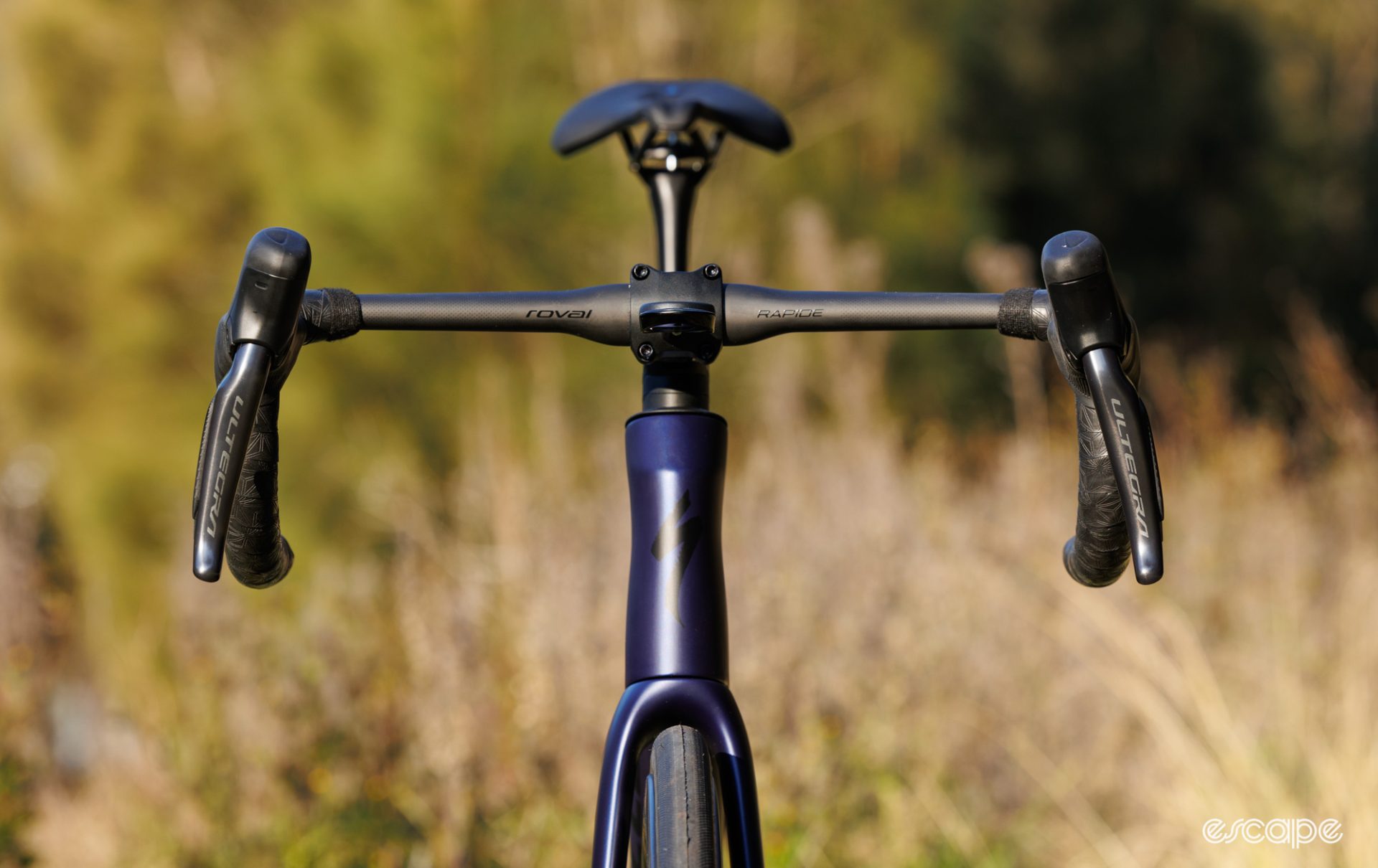
“Specialized’s component sizing is based on our global Retul fit database,” explained Hubbard, and while that may be true, I’d argue that data is not perfectly aligned to how more race-focussed riders (and in theory, the customer for this bike) are approaching fit today. My 54 cm tester comes stock with a 42 cm-width handlebar, just a touch wider than my preferred 40 cm width, but a lot wider than the 36-38 cm bars you see aero-aware racers flocking to. That narrower bar would also help to shorten the reach, and at that point, the stock stem length would have been ideal for my achy body.
Specialized is among the masses of brands to still do this, and in many ways, the two-piece system provided on the Pro version is vastly better than the more locked-in one-piece cockpits of many competitors. In fact, if your bike isn’t already built for the shop floor, then the provided handlebar is separate and easily swapped out to the same bar in a narrower width, or perhaps another brand entirely. Still, such a swap will almost always introduce further cost for a performance-focused customer looking to buy one of these bikes. And unfortunately, if that bike is already built, then yeah, that’s not exactly a quick swap for the mechanic to do (the brake hoses run through the handlebar).
Wrap up
Did Specialized sacrifice some of the Tarmac’s aerodynamic potential to be more attractive on the scale? You can bet they did, and truthfully, I’m all for it. Those potential few watts saved while riding on the front or solo at a decent clip are more than made up by a bike that just feels fantastic in every moment of the ride.
Of course, the “feel” of a bike is a tough one to justify when comparing prices, and while the SL8 is subtly better-priced than the SL7 before it, there’s still no question that Specialized is one of the more premium choices. For me, what helps is knowing that there was no part on this bike that I’d urgently want to change before owning or even racing it.
It’s hard to quantify what makes a bike feel great, and really, it’s never a single aspect. The Tarmac has a long history of producing such great sensations, and the new SL8 returns the Tarmac to that tradition. While I can’t answer whether it is in fact the fastest choice, I can say it’s quite possibly the most enjoyable race bike I’ve ridden in recent memory.
Credit where credit is due – this is one of those bikes I’m sad to be putting back into its shipping box.
Gallery
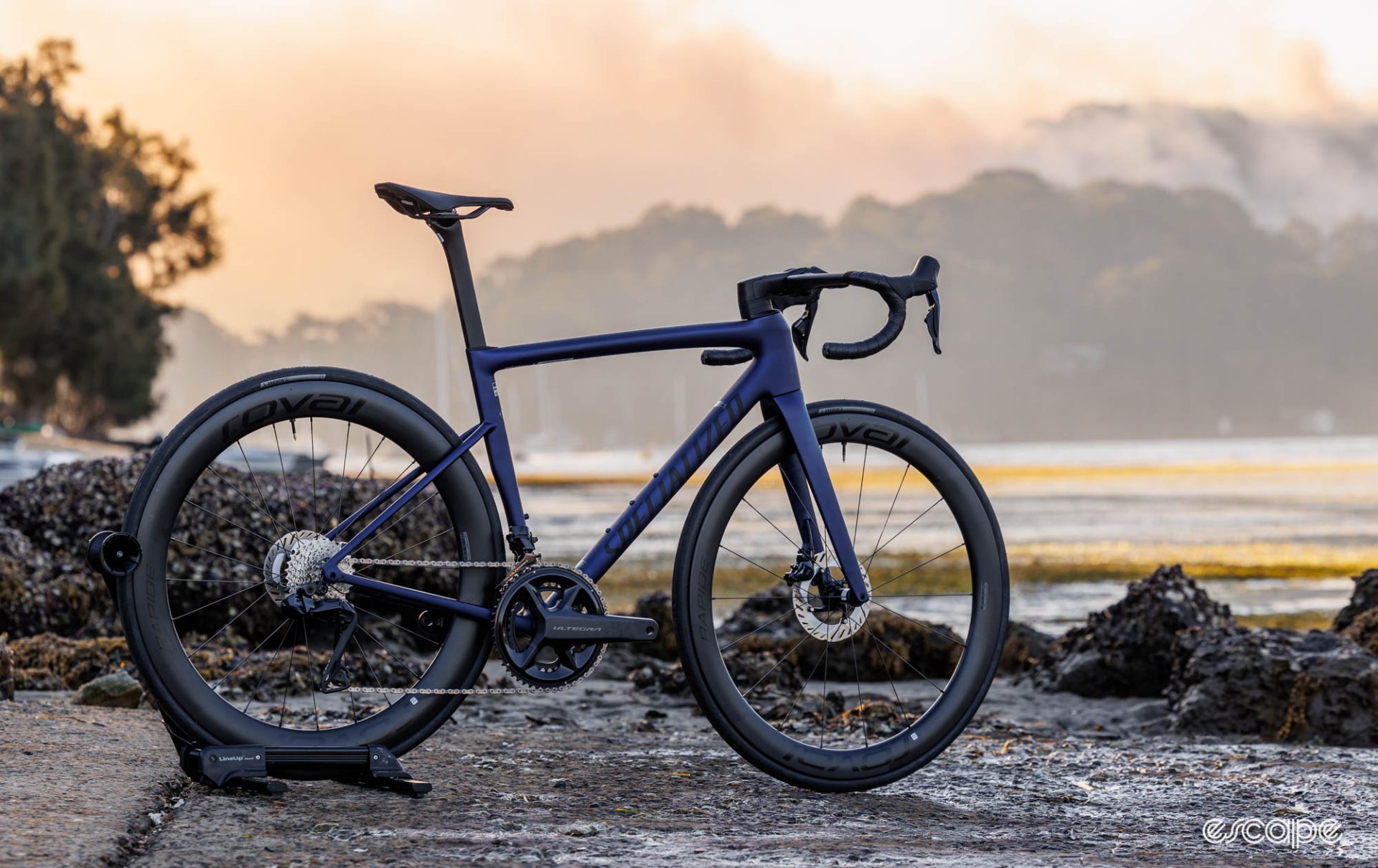
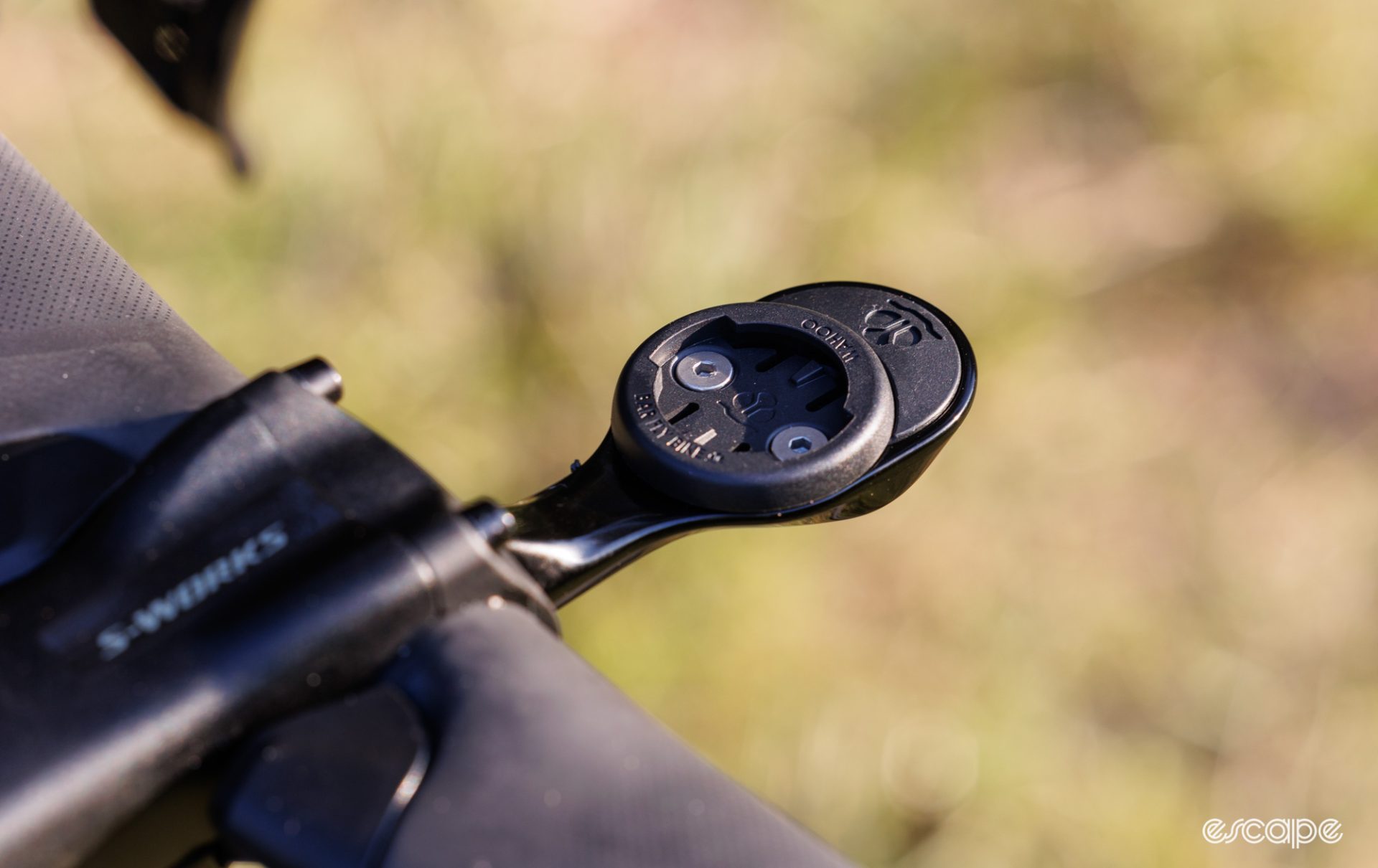

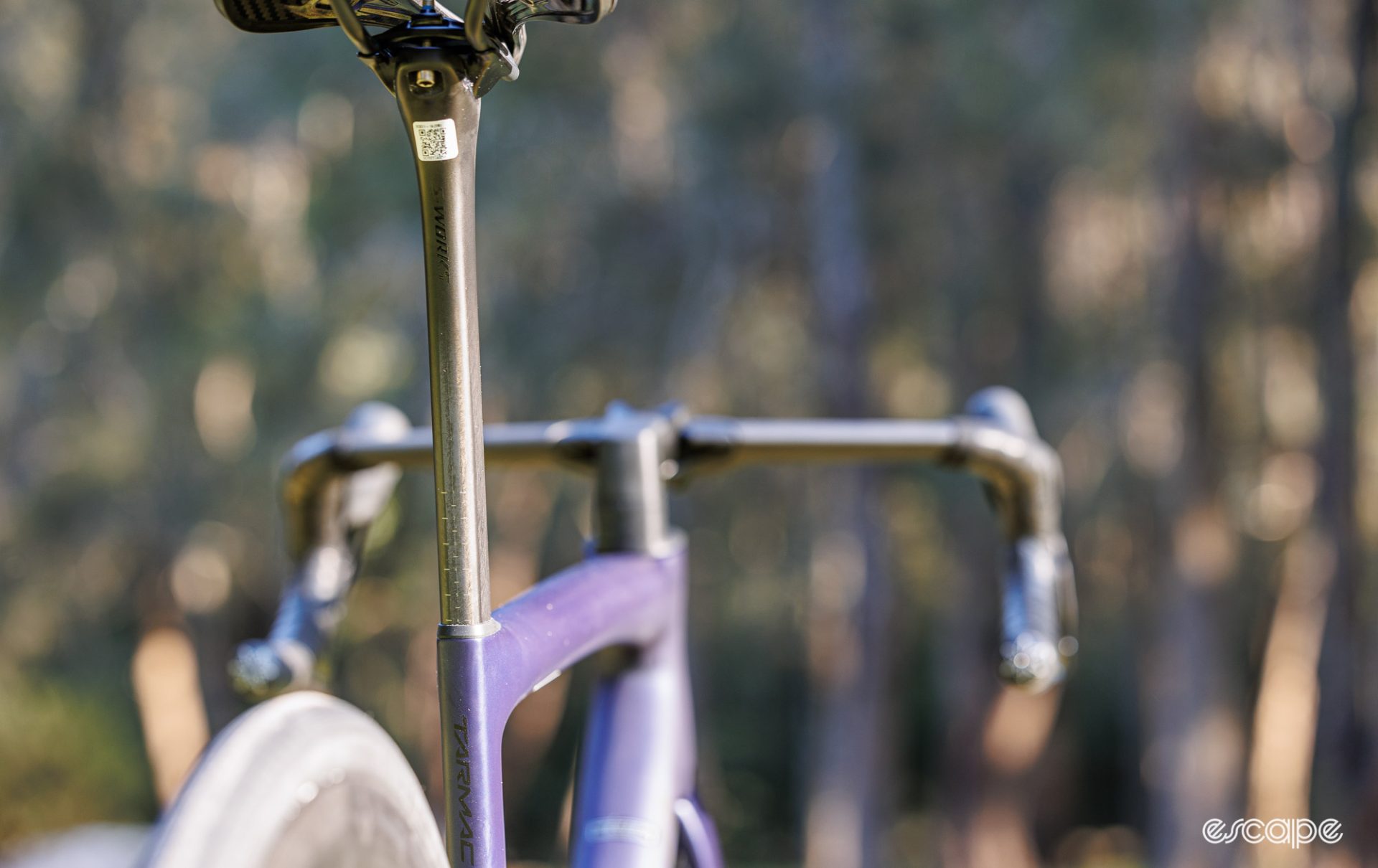



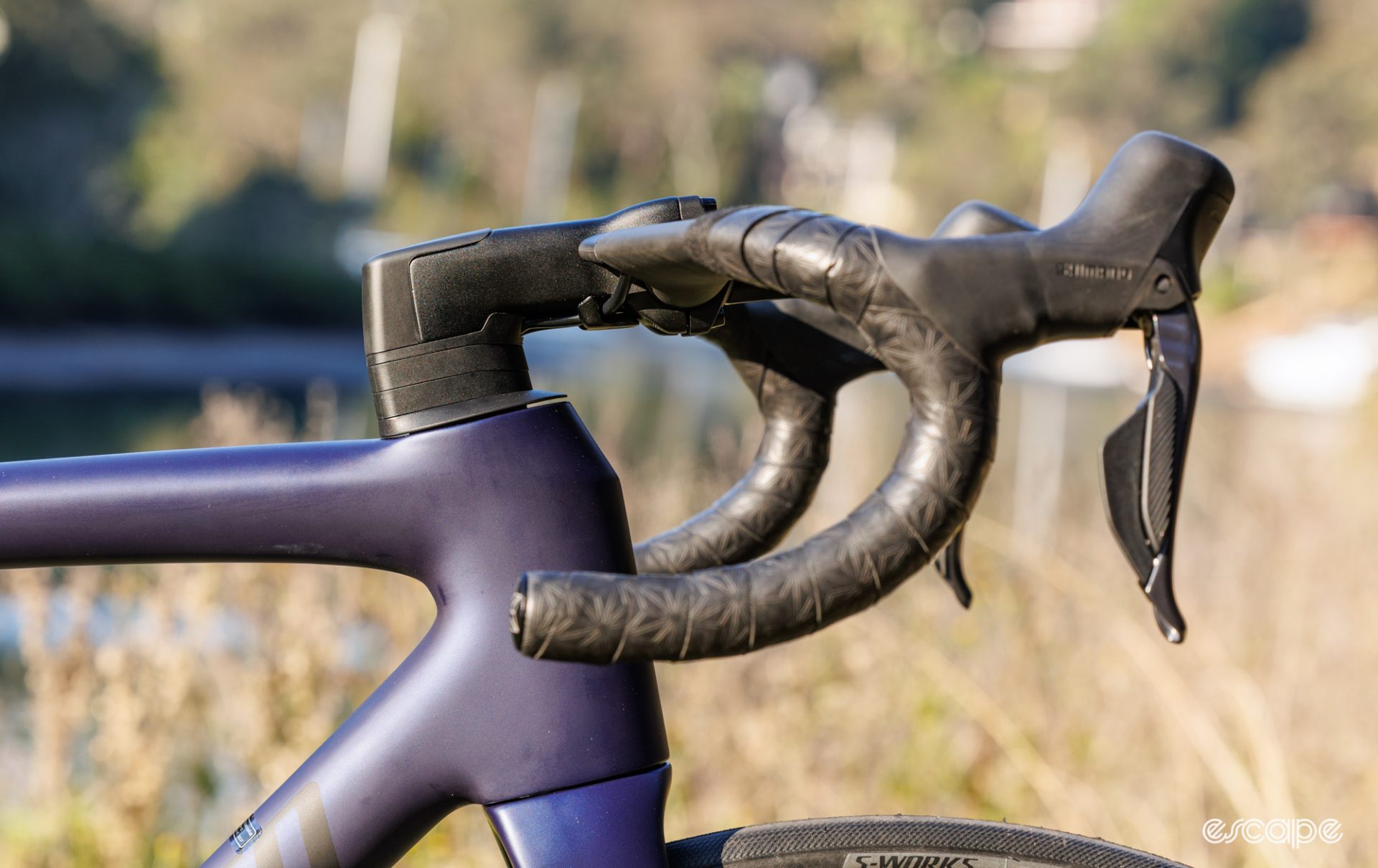

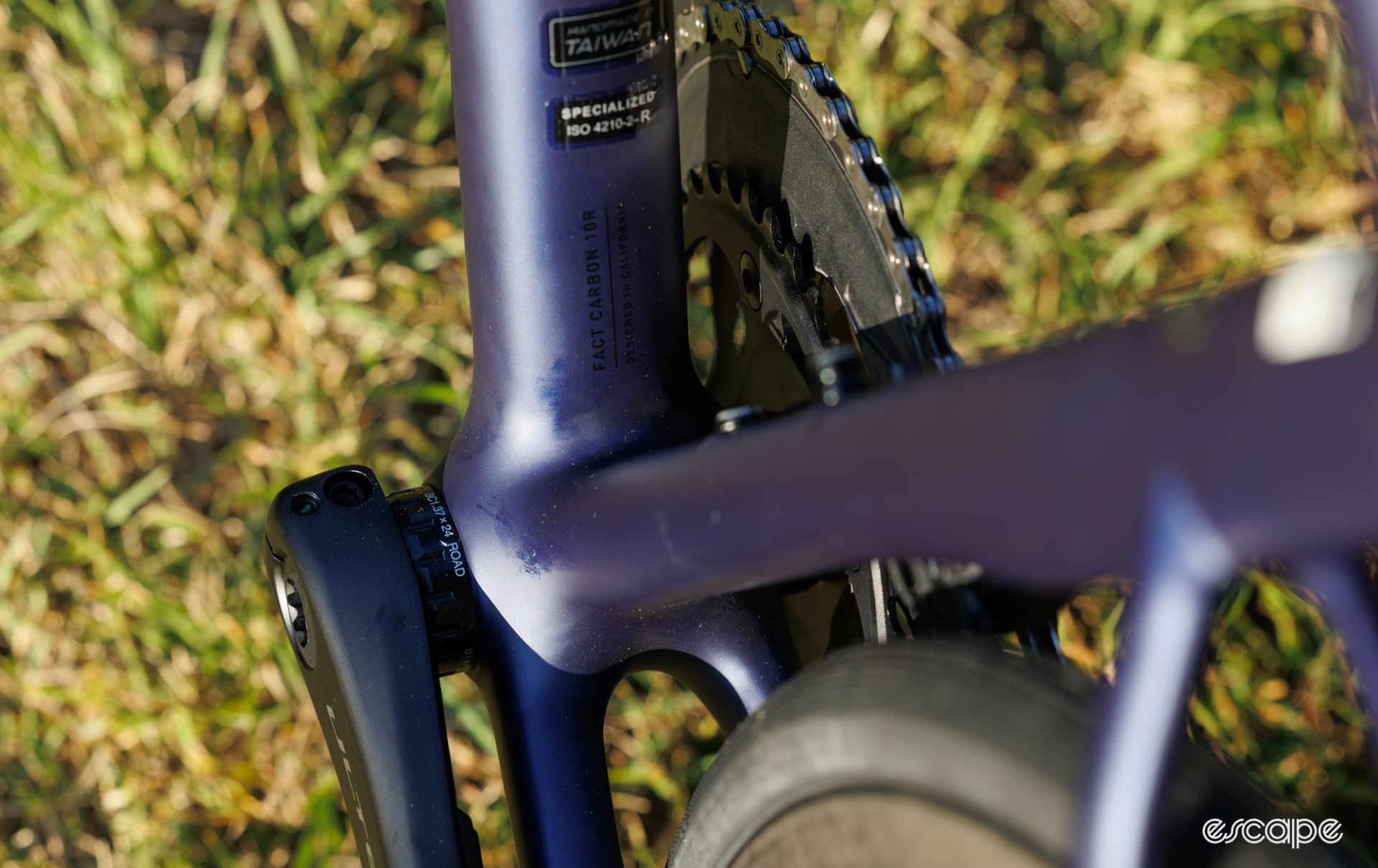

What did you think of this story?

